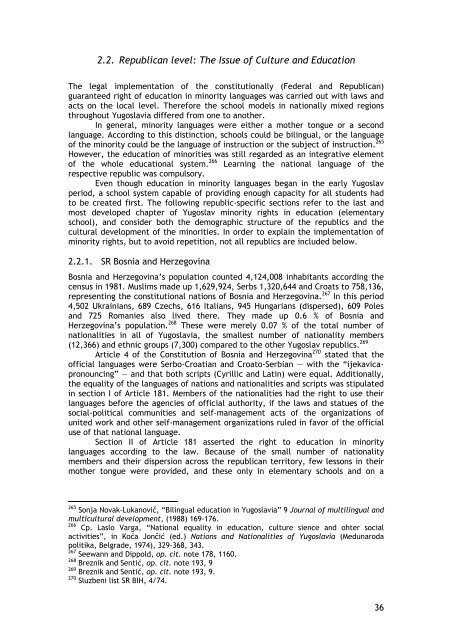Theory and practice of human Rights and minority rights ... - EURAC
Theory and practice of human Rights and minority rights ... - EURAC
Theory and practice of human Rights and minority rights ... - EURAC
Create successful ePaper yourself
Turn your PDF publications into a flip-book with our unique Google optimized e-Paper software.
2.2. Republican level: The Issue <strong>of</strong> Culture <strong>and</strong> Education<br />
The legal implementation <strong>of</strong> the constitutionally (Federal <strong>and</strong> Republican)<br />
guaranteed right <strong>of</strong> education in <strong>minority</strong> languages was carried out with laws <strong>and</strong><br />
acts on the local level. Therefore the school models in nationally mixed regions<br />
throughout Yugoslavia differed from one to another.<br />
In general, <strong>minority</strong> languages were either a mother tongue or a second<br />
language. According to this distinction, schools could be bilingual, or the language<br />
<strong>of</strong> the <strong>minority</strong> could be the language <strong>of</strong> instruction or the subject <strong>of</strong> instruction. 265<br />
However, the education <strong>of</strong> minorities was still regarded as an integrative element<br />
<strong>of</strong> the whole educational system. 266 Learning the national language <strong>of</strong> the<br />
respective republic was compulsory.<br />
Even though education in <strong>minority</strong> languages began in the early Yugoslav<br />
period, a school system capable <strong>of</strong> providing enough capacity for all students had<br />
to be created first. The following republic-specific sections refer to the last <strong>and</strong><br />
most developed chapter <strong>of</strong> Yugoslav <strong>minority</strong> <strong>rights</strong> in education (elementary<br />
school), <strong>and</strong> consider both the demographic structure <strong>of</strong> the republics <strong>and</strong> the<br />
cultural development <strong>of</strong> the minorities. In order to explain the implementation <strong>of</strong><br />
<strong>minority</strong> <strong>rights</strong>, but to avoid repetition, not all republics are included below.<br />
2.2.1. SR Bosnia <strong>and</strong> Herzegovina<br />
Bosnia <strong>and</strong> Herzegovina’s population counted 4,124,008 inhabitants according the<br />
census in 1981. Muslims made up 1,629,924, Serbs 1,320,644 <strong>and</strong> Croats to 758,136,<br />
representing the constitutional nations <strong>of</strong> Bosnia <strong>and</strong> Herzegovina. 267 In this period<br />
4,502 Ukrainians, 689 Czechs, 616 Italians, 945 Hungarians (dispersed), 609 Poles<br />
<strong>and</strong> 725 Romanies also lived there. They made up 0.6 % <strong>of</strong> Bosnia <strong>and</strong><br />
Herzegovina’s population. 268 These were merely 0.07 % <strong>of</strong> the total number <strong>of</strong><br />
nationalities in all <strong>of</strong> Yugoslavia, the smallest number <strong>of</strong> nationality members<br />
(12,366) <strong>and</strong> ethnic groups (7,300) compared to the other Yugoslav republics. 269<br />
Article 4 <strong>of</strong> the Constitution <strong>of</strong> Bosnia <strong>and</strong> Herzegovina 270 stated that the<br />
<strong>of</strong>ficial languages were Serbo-Croatian <strong>and</strong> Croato-Serbian — with the “ijekavicapronouncing”<br />
— <strong>and</strong> that both scripts (Cyrillic <strong>and</strong> Latin) were equal. Additionally,<br />
the equality <strong>of</strong> the languages <strong>of</strong> nations <strong>and</strong> nationalities <strong>and</strong> scripts was stipulated<br />
in section I <strong>of</strong> Article 181. Members <strong>of</strong> the nationalities had the right to use their<br />
languages before the agencies <strong>of</strong> <strong>of</strong>ficial authority, if the laws <strong>and</strong> statues <strong>of</strong> the<br />
social-political communities <strong>and</strong> self-management acts <strong>of</strong> the organizations <strong>of</strong><br />
united work <strong>and</strong> other self-management organizations ruled in favor <strong>of</strong> the <strong>of</strong>ficial<br />
use <strong>of</strong> that national language.<br />
Section II <strong>of</strong> Article 181 asserted the right to education in <strong>minority</strong><br />
languages according to the law. Because <strong>of</strong> the small number <strong>of</strong> nationality<br />
members <strong>and</strong> their dispersion across the republican territory, few lessons in their<br />
mother tongue were provided, <strong>and</strong> these only in elementary schools <strong>and</strong> on a<br />
265 Sonja Novak-Lukanovič, “Bilingual education in Yugoslavia” 9 Journal <strong>of</strong> multilingual <strong>and</strong><br />
multicultural development, (1988) 169-176.<br />
266 Cp. Laslo Varga, “National equality in education, culture sience <strong>and</strong> ohter social<br />
activities”, in Koća Jončić (ed.) Nations <strong>and</strong> Nationalities <strong>of</strong> Yugoslavia (Medunaroda<br />
politika, Belgrade, 1974), 329-368, 343.<br />
267 Seewann <strong>and</strong> Dippold, op. cit. note 178, 1160.<br />
268 Breznik <strong>and</strong> Sentić, op. cit. note 193, 9<br />
269 Breznik <strong>and</strong> Sentić, op. cit. note 193, 9.<br />
270 Sluzbeni list SR BIH, 4/74.<br />
36

















